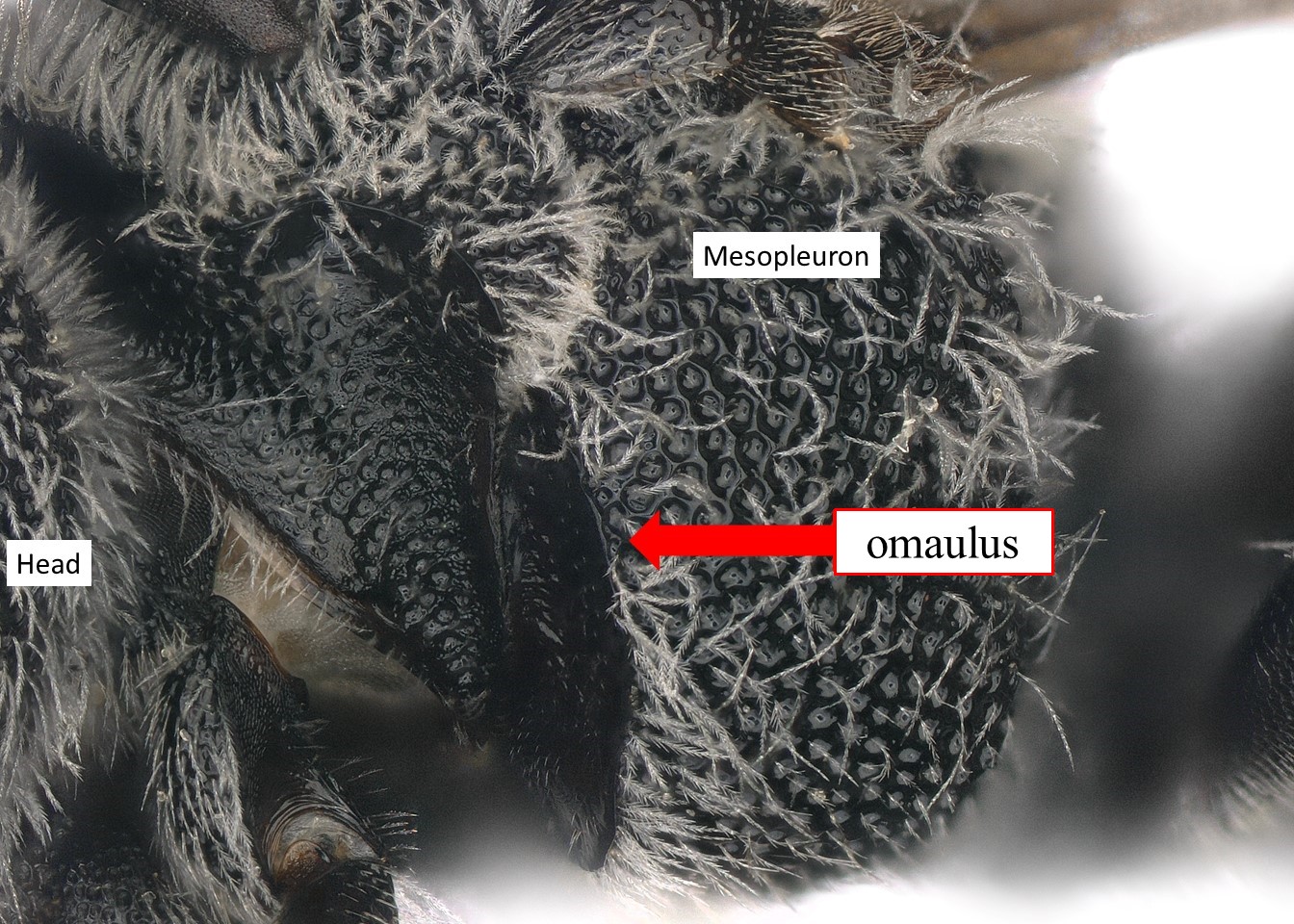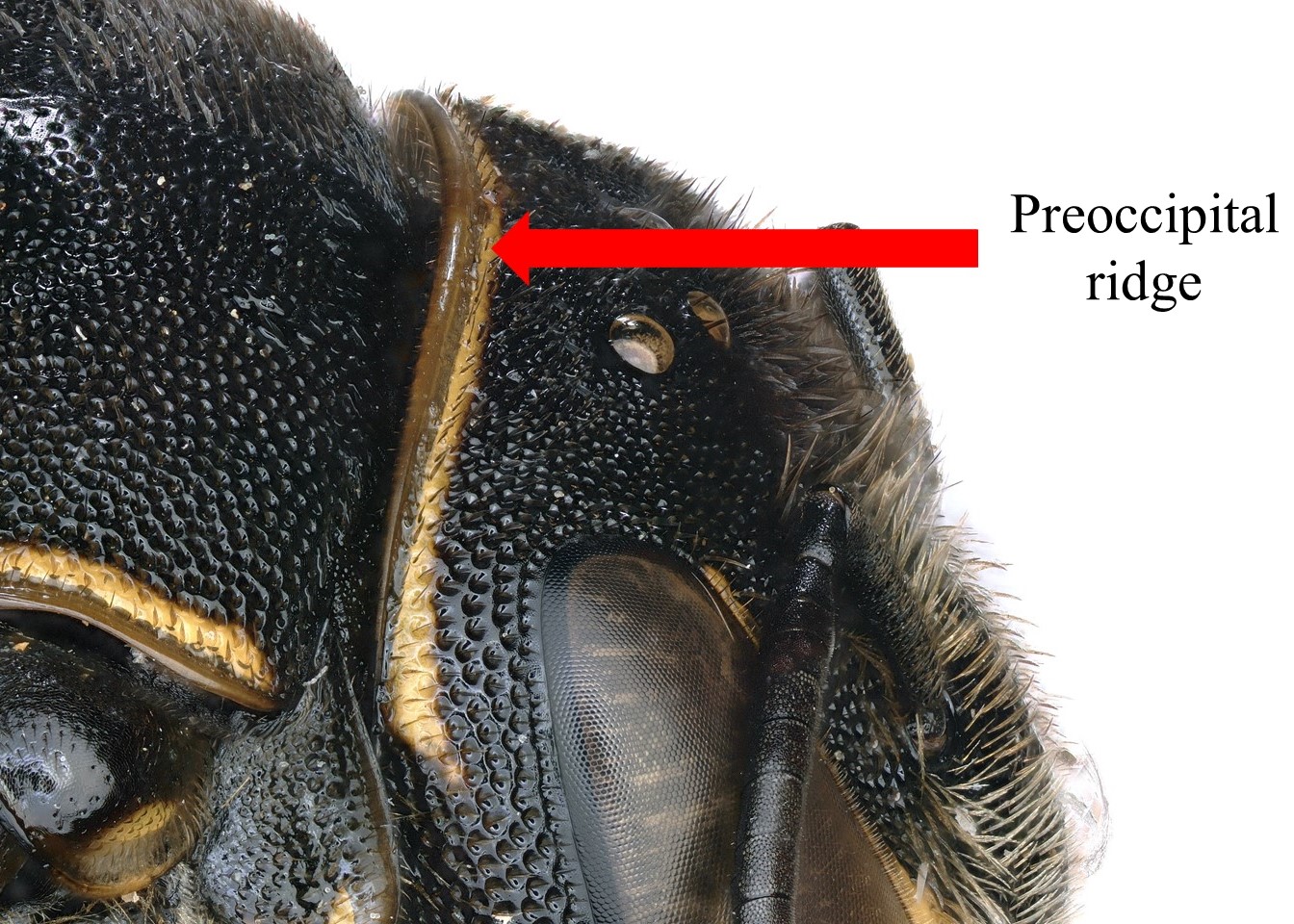Family: Megachilidae
Subfamily: Megachilinae
Tribe: Dioxyini
Genus: Aglaoapis Cameron, 1901
Subgenera: none
Common name: none
Aglaoapis are large bees that range in body length from 10–12 mm with red or black integumentintegument:
a tough, protective outer layer
on their abdomens (Griswold and Parker 2003Griswold and Parker 2003:
Griswold, T. and F.D. Parker. 2003. Stelis rozeni, new species, the first record of the parasitic bee genus Stelis from Southern Africa (Hymenoptera: Megachilidae). Journal of the Kansas Entomological Society 76: 282ndash;285.; Michener 2007Michener 2007:
Michener, C.D. 2007. The Bees of the World (2nd ed.). Johns Hopkins University Press, Baltimore and London, 953 pp.).
Aglaoapis contains 3 species (Michener 2007Michener 2007:
Michener, C.D. 2007. The Bees of the World (2nd ed.). Johns Hopkins University Press, Baltimore and London, 953 pp.); none are known to occur in the U.S. or Canada.
(modified from Michener 2007Michener 2007:
Michener, C.D. 2007. The Bees of the World (2nd ed.). Johns Hopkins University Press, Baltimore and London, 953 pp.)
 with transverse basalbasal:
with transverse basalbasal: carinatecarinate:
carinatecarinate: carinatecarinate:
carinatecarinate: broad, slightly or not exceeding T6T6:
broad, slightly or not exceeding T6T6: .
.Aglaoapis have similar external features to other genera in the Dioxyini tribe; however, Aglaoapis can be differentiated by their spined axillaaxilla:
the triangular or rounded point on the thorax where thoracic muscles meet the forewing of an insect, strong median spine on the metanotummetanotum:
the posterior dorsal segment of the thorax, behind the scutellum
, transverse carinacarina:
a clearly defined ridge or keel, not necessarily high or acute; usually appears on bees as simply a raised line
at the base of the labrumlabrum:
part of the head abutting the clypeus, folds down in front of the mouthparts
 , and the tubercletubercle:
, and the tubercletubercle:
a small knob-like or rounded protuberance
on the anterioranterior:
toward the head or on the head side of a segment being described
surface of the front coxacoxa:
the basal segment of the leg (Michener 2007Michener 2007:
Michener, C.D. 2007. The Bees of the World (2nd ed.). Johns Hopkins University Press, Baltimore and London, 953 pp.).
There are no known invasives.
Aglaoapis are cleptoparasiticcleptoparasitic:
bees that lay their eggs in the nest cells of bees in other genera. Their larvae depend on the pollen provided by their host. Since cleptoparasitic bees don't provision their own nests, and instead depend on the pollen collected by their host, the females lack pollen collecting hairs. This often gives them a wasp-like appearance.
of other bees in the family Megachilidae (Griswold and Parker 2003Griswold and Parker 2003:
Griswold, T. and F.D. Parker. 2003. Stelis rozeni, new species, the first record of the parasitic bee genus Stelis from Southern Africa (Hymenoptera: Megachilidae). Journal of the Kansas Entomological Society 76: 282ndash;285.; Michener 2007Michener 2007:
Michener, C.D. 2007. The Bees of the World (2nd ed.). Johns Hopkins University Press, Baltimore and London, 953 pp.). Females do not gather pollen from flowers since the larvaelarvae:
active immature form of an insect, especially one that differs greatly from the adult and forms the stage between egg and pupa
develop parasitically on their host’s pollen provisions (Michener 2007Michener 2007:
Michener, C.D. 2007. The Bees of the World (2nd ed.). Johns Hopkins University Press, Baltimore and London, 953 pp.). They will, however, visit a wide variety of flowers for nectar.
Aglaoapis are known cleptoparasites (Michener 2007Michener 2007:
Michener, C.D. 2007. The Bees of the World (2nd ed.). Johns Hopkins University Press, Baltimore and London, 953 pp.). Host selection boundaries, however, are not well understood. In general for bees within the Dioxyini tribe, the female parasite often spends time around the preferred floral resources of its host to locate them. Once a host nest is found, an egg is laid inside a cell as the host female is provisioning the nest (Rozen and Favreau 1967Rozen and Favreau 1967:
Rozen Jr. J.G. and M.S. Favreau. 1967. Biological notes on Dioxys pomonae pomonae and on its host, Osmia nigrobarbata (Hymenoptera: Megachilidae). Journal of the New York Entomological Society 75: 197ndash;203.), or it is injected into the cell after it has been sealed off (Rozen and Özbek 2005). After hatching from the egg, the active larvalarva:
active immature form of an insect, especially one that differs greatly from the adult and forms the stage between egg and pupa
uses its pointed mandibles to destroy the host egg or larvalarva:
active immature form of an insect, especially one that differs greatly from the adult and forms the stage between egg and pupa
(Rozen and Özbek 2004). The larvalarva:
active immature form of an insect, especially one that differs greatly from the adult and forms the stage between egg and pupa
retains the somewhat modified “ hospicidalhospicidal:
the early instars of clepoparasitic bees, which have been oviposited into complete brood cells of another species. When the early instars develop, they kill off the developing individual that was originally occupying the brood cell.
” body form for multiple instars before molting into a more ordinary grub-like form where it feeds on the pollen stores of its host (Rozen and Özbek 2004).
Aglaoapis occurs in Europe, western Asia, western India, and South Africa (Michener 2007Michener 2007:
Michener, C.D. 2007. The Bees of the World (2nd ed.). Johns Hopkins University Press, Baltimore and London, 953 pp.).
Distribution map generated by Discover Life -- click on map for details, credits, and terms of use.
Griswold, T. and F.D. Parker. 2003. Stelis rozeni, new species, the first record of the parasitic bee genus Stelis from Southern Africa (Hymenoptera: Megachilidae). Journal of the Kansas Entomological Society 76: 282-285.
Michener, C.D. 2007. The Bees of the World. 2nd ed. Johns Hopkins University Press, Baltimore and London, 953 pp.
Rozen Jr. J.G. and M.S. Favreau. 1967. Biological notes on Dioxys pomonae pomonae and on its host, Osmia nigrobarbata (Hymenoptera: Megachilidae). Journal of the New York Entomological Society 75: 197-203.
Rozen Jr., J.G. and H. Özbek. 2004. Immature Stages of the cleptoparasiticcleptoparasitic:
bees that lay their eggs in the nest cells of bees in other genera. Their larvae depend on the pollen provided by their host. Since cleptoparasitic bees don't provision their own nests, and instead depend on the pollen collected by their host, the females lack pollen collecting hairs. This often gives them a wasp-like appearance.
bee Dioxys cincta (Apoidea: Megachilidae: Megachilinae: Dioxyini). American Museum Novitates 3443: 1-12.
Rozen Jr., J.G. and H. Özbek. 2005. Egg deposition of the cleptoparasiticcleptoparasitic:
bees that lay their eggs in the nest cells of bees in other genera. Their larvae depend on the pollen provided by their host. Since cleptoparasitic bees don't provision their own nests, and instead depend on the pollen collected by their host, the females lack pollen collecting hairs. This often gives them a wasp-like appearance.
bee Dioxys cincta (Hymenoptera: Apoidea: Megachilidae). Journal of the Kansas Entomological Society 78: 221-226.